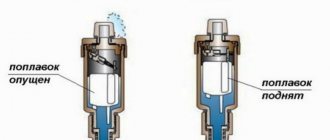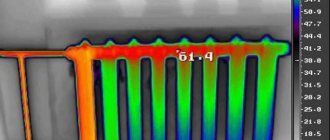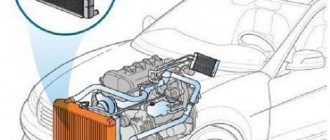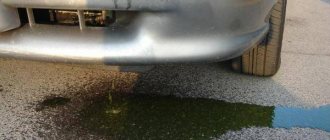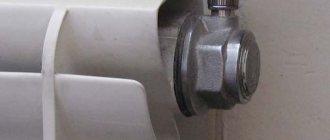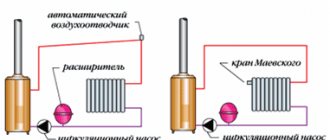Security / From Yuri Yakovlev
- Reasons for air accumulation in antifreeze
Video: How not to air the cooling system when filling with antifreeze
- Video: Lada Kalina. Air accumulation in the cooling system
- Video: How to remove air from the expansion tank
An air lock in the cooling system leads to disruption of heat removal from areas of increased heat generation: pistons, cylinders, intake and exhaust manifolds. Such unstable operation of the engine cooling system can cause overheating. Prolonged operation of a car with an air lock can result in serious repair costs.
Possible consequences of an air lock in a car's cooling system
The presence of air in the coolant leads to many unpleasant consequences. The normal circulation of antifreeze (antifreeze) is immediately disrupted and the main purpose of the cooling system begins to suffer:
- heat removal from the components of a running engine occurs unevenly;
- heating the air in the cabin does not provide the necessary comfort.
An experienced driver will immediately notice the twitching of the coolant temperature gauge needle and its boiling in the cooling system. An air lock in the coolant causes:
- overheating of engine parts and components at idle speed, which leads to temperature jumps;
- incorrect operation of the sensors - this causes malfunctions in the temperature indicator readings;
- inaccuracies in the operation of the thermostat, which can cause engine overheating;
- insufficient heating of the stove will cause fogging of the windshield and side windows, which will lead to limited visibility and the creation of an emergency situation on the road.
Reasons for appearance
There are several reasons why air accumulates in the cooling system channels. An air lock is formed due to:
- System leaks. Leaks at the junctions of the pipes lead to the fact that when the liquid flow moves, a vacuum is formed, which sucks air into the system. Gradually the amount of air increases, then it accumulates in one place, forming a plug.
- Loss of tightness in the water pump. If the sealing gasket under the pump is damaged, the unit will suck in air during operation.
- Violation of technology for replacing or adding antifreeze. If you immediately pour a large amount of liquid, the air in the pipes will not escape and the antifreeze will push air bubbles into the system with its own weight. After starting the engine, the air will gather in one place, interrupting the flow.
- Damage to the cylinder head gasket due to overheating. If the resulting breakdown connects the cooling system channel to the atmosphere, the liquid will draw in air from outside. Airing appears if a breakdown connects the channel to the cylinder. In this case, exhaust gases will break into the cooling system, which, in addition to the appearance of an air lock, is accompanied by the bubbling of antifreeze in the expansion tank.
If you suspect that a plug has formed in the cooling system, first make sure that air has occurred. Overheating of the power plant occurs due to jamming of the thermostat, which is also an unpleasant situation.
Causes of air accumulation in antifreeze
General diagram of a liquid cooling system
Closed liquid cooling systems are designed to maintain constant excess pressure (up to 100 kPa). The increased pressure made it possible to raise the boiling point of the liquid to 120 degrees. Since cars are used all year round, a concentrated, special non-freezing coolant was specially developed for them - antifreeze (antifreeze is the most popular). It consists of ethylene glycol, distilled water and anti-corrosion, anti-foaming, antioxidant additives. Antifreeze provides optimal thermal operating conditions for the engine of 80–100 degrees in any weather. The main causes of air locks are as follows:
- Air suction through insufficiently tight connections of pipes, hoses, fittings, tubes. This happens because when antifreeze moves through the system, a reduced pressure is created near the walls of the tubes, which draws in outside air in places with loose connections.
- Air is trapped in the cooling system when a wide mouth funnel is used to add or change coolant. A powerful flow of antifreeze blocks the path of air to the top. Antifreeze is always poured into the expansion tank or radiator in a thin stream.
Antifreeze circulation diagram in the engine cooling system Modern cars use a forced closed cooling system. Its main task is to ensure stable operation of the engine during the transition from cooling mode to heating mode and vice versa. This is not easy to achieve, since when the antifreeze is heated, its volume increases and excess pressure arises, and when it cools, the volume and pressure in the system decreases. The increased pressure compresses the air at the highest point of the system - the expansion tank. There is an air valve in the filler plug of the tank that operates in two directions. When the pressure increases, it bleeds excess air out; when the pressure decreases, it lets outside air into the system. It is the air valve that maintains constant excess pressure under any thermal conditions. If this device does not work correctly, excess air will begin to constantly accumulate in the cooling system. - When the sealing fiber and seal at the booster pump wear out, outside air may begin to leak into the coolant.
- Leakage of antifreeze in hoses, pipes, cooling and heating radiators leads to a decrease in its volume and an increase in the volume of air in the expansion tank. Clogging of the core of radiators with debris and defects in their outer shells create the preconditions for engine overheating due to poor cooling of antifreeze. All these reasons, taken together and individually, lead to the formation of an air lock in the cooling system.
- A burnt-out cylinder head gasket often leads to antifreeze leaking into the engine crankcase (the oil level on the dipstick will be above the maximum permissible level) or into the exhaust system (smoke from the exhaust pipe will be white). Reducing the volume of antifreeze leads to its boiling due to the formation of air accumulations in the cooling system.
Video: How not to air out the cooling system when filling with antifreeze
Universal filling platform (clip) for pumping cartridges
383.00 rub.
Buy The disadvantage of this method is the high consumption of ink, because... Not all colors are filled evenly.
Photo 7
How to bleed CISS in Canon printers, where the print head is separate from the cartridges
I do this in two ways:
1. As in the previous case, I fill the cartridges, fill the ink cable with ink, connect one to the other, and install it back into the printer.
2. The second method is probably for the lazy, but you need to get the hang of it, the point is that you raise the ink containers above the cartridges by about 20cm. and the ink begins to flow by gravity into the cartridge. But because The cartridges are not always filled evenly, so you have to cover the outlet holes of the cartridges with something, often your fingers :)
In conclusion, I note that the CISS works stably with fresh ink and when it is sealed, if this is not the case, then there will always be air in the tubes and any other problems with print quality.
Approach any task wisely and everything will work out for you!
In this article, I tried to share as much of my knowledge in this area as possible with the hope that someone will be able to help in this delicate and sometimes difficult matter. The article will most likely be supplemented with pictures and videos, so come back often :)
I will be glad to receive your comments, and don’t be lazy to share the article on social media. networks by clicking the special buttons below!
You can repair or update your printer in Simferopol at the service center on the street. Starozenitnaya, 9 (entrance from the fence). Please contact us during business hours from 9.00-18.00 at +7 (978) 797-66-90
Don't forget to rate the post and share it with your friends on social networks by clicking the special buttons below. Don't forget to leave a comment and subscribe to our Youtube
Save
Save
Rate this article:
(
28 ratings, average: 4.25 out of 5)
Share with friends:
Related posts:
PG-445, PG-46, CL-446, CL-56: instructions for refilling cartridges for the Ca…
Instructions for installing CISS on Canon Pixma MG2440, MG2540, MG2940 and Ink Efficie…
Installing a printer without a disk: finding the right driver correctly
Instructions for refilling Canon PG-37, PG-40, PG-50, PG-510, PG-512, CL-… cartridges
Installing CISS on Epson Expression Premium XP-600, XP-605, XP-700, XP-8… printers
Recommended products:
- 119 in stock
How to determine if there is a problem: symptoms, signs, diagnosis
Diagnostics are designed to help find the cause of malfunctioning cooling system. If antifreeze constantly disappears somewhere, boils, boils strongly in the cooling radiator, and the interior does not heat up, all this needs to be dealt with. If the antifreeze level regularly drops, air will take its place, which over time will form an air lock. In this case, you need to check the tightness of all connections of the engine cooling system. To do this, carry out a careful external inspection of the interfaces of rubber parts (hoses, pipes) with tubes and fittings with a warm, running engine. Pay special attention to the radiator pipes, water pump, thermostat and heater hoses. If a leak is detected, it must be eliminated by replacing the pipes or tightening the steel clamps.
The main burden of adjusting (while the engine is warming up) and maintaining a constant (while the engine is running) temperature in the cooling system falls on the thermostat. If the engine begins to warm up very quickly after starting, the electric fan starts almost simultaneously, and the arrow on the indicator tends to move into the red zone - these signs indicate a malfunction of the thermostat or an accumulation of air in the discharge pipe from the pump. The thermostat valve will be closed all the time, and the antifreeze will circulate only in a small circle.
Air accumulation in the thermostat: process diagram
But if the engine takes a long time to warm up, and the needle is frozen at the beginning of the scale, this is a sign of a constantly open valve at the thermostat or the formation of an air lock in the thermostat itself. An open valve cannot switch the antifreeze circulation to a small circle to quickly warm up the engine.
To check that the thermostat is working correctly, you need to start the engine and let it run until the temperature gauge needle starts moving. We touch the cooling radiator pipes with our hands. The top one should be warm and the bottom one should remain cold. As the engine continues to operate, the pipe at the top of the radiator should become increasingly hotter, and the lower pipe should remain the same cold. When the engine warms up and the temperature reaches 80–90 degrees, the thermostat valve will open. At this time, the lower radiator pipe will first be warm and then hot.
The technical condition of the water pump can be judged by its operating noise; absence of antifreeze leakage through the oil seal; absence of vibrations due to wear of the bearing on the pump shaft. Leakage of antifreeze indicates air leakage and the formation of air accumulations in the cooling system.
To summarize: outside air can enter a closed engine cooling system in three cases:
- in case of inept filling of antifreeze into the system when replacing it and adding it to the norm;
- in case of partial depressurization of the system and air leaks through loose connections;
- if the air valve of the expansion tank breaks down.
Since air is much lighter than coolant, it will always tend to rise. Therefore, the methods for removing air accumulations from the cooling system are the same for all types of internal combustion engines (diesel, carburetor, longitudinal or transverse, V-shaped or in-line, etc.).
The surest sign of air accumulation in the cooling system is poor heat supply by the stove when the engine is normally warmed up.
Video: Lada Kalina. Air accumulation in the cooling system
How to bleed air using the VAZ model range as an example
VAZ models have a design advantage in the arrangement of cooling system components - a convenient position of the cooled throttle assembly (carburetor), which is the highest place in the cooling system. The procedure for a Lada Kalina car is as follows (the only tool you need is a Phillips screwdriver).
- Fully open the heater switch (to the highest temperature);
- Remove the valve cover protective screen;
Disconnected heating outlet hose from the throttle fitting - Loosen the clamp and remove the heating inlet or outlet hose from the throttle fittings;
Remove the cap from the expansion tank - Unscrew the cap of the expansion tank;
- Through a clean piece of fabric at the neck of the expansion tank, we pump air using the mouth until antifreeze flows out of the throttle fitting or heating hose;
- Quickly insert the hose into place and secure it with a clamp;
- We reinstall all the removed parts.
Video: How to remove air from the expansion tank
The second method of releasing air differs from the first only in that you do not need to force air masses into the neck of the expansion tank with your mouth. All operations are performed with the engine normally warmed up and turned off. This method does not involve any manipulations with the expansion tank cap. Immediately remove one of the two heating hoses from the throttle fittings. If coolant leaks, the hose is inserted into place and tightened. It may not work out the first time, then the operation must be done again. This method requires care and caution, since the antifreeze is heated to a temperature of 90 degrees and is under increased pressure.
The third method does not require any disassembly of the cooling system. True, its effectiveness is not very high. The car drives its front wheels onto an embankment so that the radiator cap becomes the highest point in the cooling system. The radiator and expansion tank caps are removed. The engine starts, the antifreeze temperature is brought to operating parameters. When reducing the volume of coolant, it must be constantly added to the amount recommended by the manufacturer. It is necessary to expel the air lock until bubbles stop coming out of the neck of the radiator or expansion tank.
How to remove an air lock using the example of a VAZ-2109
To ventilate the cooling system, three methods are used, each of which copes with the task.
The simplest method, which is applicable both for the VAZ-2109 and other cars, is to remove the air lock from the engine. To do this, find a steep slope and drive the car up onto it with the front end up.
Air accumulates at the highest point of the system - in the stove radiator. After installing the car on a slope, the highest point becomes the upper tank of the main radiator, connected by a return pipe to the expansion tank.
After placing the car on the slope, we immobilize it with the handbrake (chocks or other stops will not hurt).
It’s easy to remove air in this way - after installing the car, set the engine speed to medium and hold it. The pump actively pumps liquid and pushes the plug to the top point.
During work, the liquid circulates and its level in the expansion tank may drop, so monitor the amount of antifreeze and add it.
Since the radiator is connected to the expansion tank, when the pump operates intensively, air will first enter the radiator and then be forced out by liquid into the expansion tank.
An indicator that air has left the cooling system will be a stable stream of antifreeze without air bubbles coming out of the return pipe coming from the radiator.
You can remove the cork using another second method.
To do this, find the carburetor heating pipe (throttle valve - on the injection version of the VAZ-2109) and remove it. Then unscrew the cap of the expansion tank and add fluid if necessary.
To expel the plug, create pressure in the system. To do this, blow forcefully into the tank. But it’s easier to find a suitable cap and embed a spool from a tubeless tire into it, then create pressure in the system with a pump or auto-compressor.
The essence of the method is that by creating pressure in the tank, we push the liquid out of the tank. In this case, the liquid, having reached the plug, will begin to shift it to the place where the pressure drops. This is a removed carburetor (throttle) heating pipe. A signal that the plug has come out will be the appearance of a stream of antifreeze from the pipe.
The third method is built on the same principle as the second, but it uses the engine itself to create pressure. We start the engine and let it run for 15-20 minutes (during this time, pressure will build up in the system due to the expansion of antifreeze when heated).
Then we unscrew the carburetor (throttle) warm-up pipe and wait until the pressure causes the plug to come out and antifreeze flows out of the removed tube. But this method is only applicable if the expansion tank cap valves are working properly and do not allow air to pass through.
Using such simple methods, you can de-air the cooling system of the VAZ 2109. The main indicator that the procedure was a success is the restoration of the functionality of the interior heating system. But if the stove does not heat, the procedure will have to be repeated.
